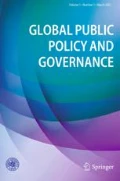Abstract
International governmental networks used to be centralized. However, the formal and informal decentralization of diplomatic relations through local governments and regions has placed the subnational governments as international actors. The subnational parallel pursuit of international relations has been termed paradiplomacy. Knowing “why or how” subnational governments engage in paradiplomacy is relevant because international networks have the potential to foster innovation, cooperation, transfer of knowledge, and international aid. However, not all jurisdictions engage in international relations despite the potential symbolic and material benefits. Scholars have explained local engagement in international relations through economic, cooperative, and political considerations. Without denying their explanatory power, we hypothesize that organizational structures, specifically local pro-international structures, foster paradiplomacy, while political support discourages paradiplomatic activities. To investigate subnational variation in paradiplomacy engagement, we rely on a survey covering all 5565 Brazilian municipalities in 2012. Findings suggest the existence of local pro-international structures is positively correlated with municipal international projects and municipal participation in international networks.


Similar content being viewed by others
References
Agranoff, R., & McGuire, M. (1998). Multi-network management: Collaboration and the hollow state in local economic policy. Journal of Public Administration Research and Theory, 8, 67–91.
Aguirre, I. (1999). Making sense of paradiplomacy? An intertextual enquiry about a concept in search of a definition. Regional & Federal Studies, 9(1), 185–209.
Avellaneda, C. N. (2009). Municipal performance: Does mayoral quality matter? Journal of Public Administration Research and Theory, 19(2), 285–312.
Baldridge, J. V., & Burnham, R. A. (1975). Organization innovation: Individual, organizational, and environmental impacts. Administrative Science Quarterly, 20, 165–175.
Beck, E. M., & Betz, M. (1975). A comparative analysis of organizational conflict in schools. Sociology of Education, 48, 59–74.
Blau, P. M., Blau, M., Herman, J. L., & Schoenherr, R. A. (1971). Structure of organizations (Vol. 10). Basic Books.
Blau, P. M., Heydebrand, W. V., & Stauffer, R. E. (1966). The structure of small bureaucracies. American Sociological Review, 37, 179–191.
Cason, J. W., & Power, T. J. (2009). Presidentialization, pluralization, and the rollback of Itamaraty: Explaining change in Brazilian foreign policy making in the Cardoso-Lula era. International Political Science Review, 30(2), 117–140.
Chaloux, A., & Paquin, S. (2013). Green paradiplomacy and water resource management in North America: The case of the Great Lakes-St. Lawrence River Basin. Canadian Foreign Policy Journal, 19(3), 308–322.
Chambers, G. (2012). Europe and beyond: The development of sub-state paradiplomacy with special reference to Catalonia. Romanian Journal of Society and Politics, 7(1), 7–26.
Constantinou, C. (2016). Everyday diplomacy: Mission, spectacle and remaking of diplomatic culture. In J. Dittmer & F. McConnell (Eds.), Diplomatic cultures and international politics: Translations, spaces and alternatives (pp. 23–40). Routledge.
Cornago, N. (2000). Exploring the global dimensions of paradiplomacy. Functional and normative dynamics in the global spreading of subnational involvement in international affairs. In Workshop on constituent units in international affairs. Forum of Federations. Alemania, Octubre.
Dalton, D. R., Todor, W. D., Spendolini, M. J., Fielding, G. J., & Porter, L. W. (1980). Organization structure and performance: A critical review. Academy of Management Review, 5(1), 49–64.
Dickson, F. (2014). The internationalization of regions: Paradiplomacy or multi-level governance? Geography Compass, 8(10), 689–700.
DiMaggio, P. J., & Powell, W. W. (1983). The iron cage revisited: Institutional isomorphism and collective rationality in organizational fields. American Sociological Review, 48, 147–160.
Dommergues, P. (1992). The strategies for international and interregional cooperation. Ekistics, 59(352/53), 7–12.
Duchacek, I. (1990). Perforated sovereignties: towards a typology of new actors in international relations. In Federalism and international relations: The role of subnational units (Vol. 1(2)).
Duchacek, I. D. (1984). The international dimension of subnational self-government. Publius: the Journal of Federalism, 14(4), 5–31.
Fernandez, S. (2005). Developing and testing an integrative framework of public sector leadership: Evidence from the public education arena. Journal of Public Administration Research and Theory, 15, 197–217.
George, B., Van de Walle, S., & Hammerschmid, G. (2019). Institutions or contingencies? A cross-country analysis of management tool use by public sector executives. Public Administration Review, 79(3), 330–342.
Grydehøj, A. (2014). Goals, capabilities, and instruments of paradiplomacy by subnational jurisdictions. In Local actions in a global context: paradiplomacy by subnational jurisdictions (pp. 10–20).
Hage, J., & Aiken, M. (1969). Routine technology, social structure, and organization goals. Administrative Science Quarterly, 14, 366–376.
Hage, J., & Dewar, R. (1973). Elite values versus organizational structure in predicting innovation. Administrative Science Quarterly, 78, 270–290.
Harakan, A., Mustari, N., & Abel, A. K. (2021). Sustainable energy investment through paradiplomacy practices in South Sulawesi, Indonesia. In E3S Web of conferences (Vol. 277). EDP Sciences.
Hocking, B. (1993). Non-central governments and multilayered diplomacy. In Localizing foreign policy (pp. 31–69). Palgrave Macmillan.
Issundari, S. (2018). Paradiplomacy and Indonesian public diplomacy. In 2018 3rd International conference on education, sports, arts and management engineering (ICESAME 2018) (pp. 156–159). Atlantis Press.
Jackson, T. (2018). Paradiplomacy and political geography: The geopolitics of substate regional diplomacy. Geography Compass, 12(2), e12357.
Joenniemi, P., & Sergunin, A. (2014). Paradiplomacy as a capacity-building strategy: The case of Russia’s northwestern subnational actors. Problems of Post-Communism, 61(6), 18–33.
Keating, M. J., & Aldecoa, F. (1999). Paradiplomacy in action: The foreign relations of subnational governments. Frank Cass & Co.
Keating, M. (2000). Paradiplomacy and regional networking. In Forum of federations: An international federalism, Hanover.
Kincaid, J. (1990). Constituent diplomacy in federal policies and the nation-state: Conflict and co-operation. In Federalism and international relations: The role of subnational units, 54–75.
Kuznetsov, A. (2014). Theory and practice of paradiplomacy: Subnational governments in international affairs. Routledge.
Lawrence, P. R., & Lorsch, J. W. (1967). Differentiation and integration in complex organizations. Administrative Science Quarterly, 12, 1–47.
Leandro, F. J., & Simões, J. (2020). The role of paradiplomacy in innovation: The case of African Portuguese-Speaking countries. PaKSoM 2020, 65.
Lecours, A. (2008). Political issues of paradiplomacy: Lessons from the developed world. Netherlands Institute of International Relations’ Clingendael’.
Liu, T., & Song, Y. (2021). Trajectories to becoming international relations actors in China’s BRI Initiative: A comparative study of the Guangdong and Yunnan provinces. The Pacific Review, 34(5), 778–809.
Maia, J. N. B., & Saraiva, J. F. S. (2012). A paradiplomacia financeira no Brasil da República Velha, 1890–1930. Revista Brasileira De Política Internacional, 55(1), 106–134.
McMillan, S. L. (2009). Looking beyond the national level: Foreign direct investment attraction in US states. International Interactions, 35(2), 155–178.
Meier, K. J. (2000). Politics and the bureaucracy: Policymaking in the fourth branch of government (4th ed.). Harcourt College Publishers.
Meireles, T. O. (2016). Da diplomacia federativa à cooperação internacional federativa. Dissertação de Mestrado, Faculdade de Filosofia, Letras e Ciências Humanas, Universidade de São Paulo, São Paulo.
Milani, C. R., & Ribeiro, M. C. M. (2011). International relations and the paradiplomacy of Brazilian cities: Crafting the concept of local international management. BAR-Brazilian Administration Review, 8(1), 21–36.
Mukti, T. A. (2019). Paradiplomacy and the future of Aceh government. In 1st Aceh global conference (AGC 2018). Atlantis Press. (Vol. 10).
Nganje, F. (2014). Paradiplomacy and the democratisation of foreign policy in South Africa. South African Journal of International Affairs, 21(1), 89–107.
Njaramba, R. N. (2019). Role of subnational governments in international relations. Doctoral dissertation, University of Nairobi.
Novialdi, R., Ahmad, R., Muhammad, Z., Saputra, J., & Bon, A. T. (2021) A review of paradiplomacy literature: mini-review approach.
O’Toole, L., Jr., & Meier, K. J. (2004). Public management in intergovernmental networks: Matching structural networks and managerial networking. Journal of Public Administration Research and Theory, 14, 469–494.
OECD. (2020). Official Development Assistance Detailed Summary. https://www.oecd.org/dac/financing-sustainable-development/development-finance-data/ODA-2020-detailed-summary.pdf.
Paquin, S. (2020). Paradiplomacy. In Global diplomacy (pp. 49–61). Palgrave Macmillan.
Paquin, S. (2021). Trade paradiplomacy and the politics of international economic law: The inclusion of Quebec and the exclusion of Wallonia in the CETA negotiations. New Political Economy, 27(4), 597–609.
Prado, D. F. M. (2020). Subnational activism and conflicts within Jair Bolsonaro’s government: An analysis of the Brazilian states’ actions in the Sustainable Development Goals (SDG) agenda during 2019. Estudos Internacionais: Revista De Relações Internacionais Da PUC Minas, 9(3), 114–132.
Pugh, D. S., Hickson, D. J., Hinings, C. R., & Turner, C. (1968). Dimensions of organization structure. Administrative Science Quarterly, 13, 65–105.
Rainey, H. G. (1997). Understanding and managing public organizations (2nd ed.). Jossey-Bass.
Rainey, H. G., Fernandez, S., & Malatesta, D. (2021). Understanding and managing public organizations (6th ed.). Wiley.
Rieger, F. C., & Brum, A. L. (2020). Paradiplomacia e Desenvolvimento Regional: Uma Proposta de Cooperação entre Governos Locais. Rde-Revista de Desenvolvimento Econômico, 3(44).
Rodrigues, G. M. A., & Mattioli, T. (2017). Paradiplomacy, security policies and city networks: The case of the Mercocities Citizen Security Thematic Unit. Contexto Internacional, 39, 569–587.
Scott, W. R., & Davis, G. F. (2007). Organizations and organizing. Taylor and Francis.
Slaughter, A. M. (2004). Disaggregated sovereignty: Towards the public accountability of global government networks. Government and Opposition, 39(2), 159–190.
Soldatos, P., & Michelmann, H. J. (1992). Subnational units’ paradiplomacy in the context of European integration. Journal of European Integration, 15, 129–134.
Surwandono, S. (2018). The dynamics of paradiplomacy practices in the “Frontier” areas in Indonesia. Journal of ASEAN Studies, 6(2), 137–154.
Vigevani, T. (2006). Problemas para a atividade internacional das unidades subnacionais: Estados e municípios brasileiros. Revista Brasileira De Ciências Sociais, 21(62), 127–139.
Wolff, S. (2007). Paradiplomacy: Scope, opportunities and challenges. The Bologna Center Journal of International Affairs, 10(1), 141–150.
Zamorano, M. M., & Rodríguez Morató, A. (2015). The cultural paradiplomacy of Barcelona since the 1980s: Understanding transformations in local cultural paradiplomacy. International Journal of Cultural Policy, 21(5), 554–576.
Zhao, J., Ren, L., & Lovrich, N. (2010). Police organizational structures during the 1990s: An application of contingency theory. Police Quarterly, 13(2), 209–232.
Author information
Authors and Affiliations
Corresponding author
Ethics declarations
Conflict of interest
The authors certify that they have no conflict of interest in the subject matter or materials discussed in this manuscript.
Additional information
Publisher's Note
Springer Nature remains neutral with regard to jurisdictional claims in published maps and institutional affiliations.
Appendix
Appendix
Rights and permissions
About this article
Cite this article
Fantoni, M., Avellaneda, C. Explaining paradiplomacy: do local pro-international structures and political support matter?. GPPG 2, 353–375 (2022). https://doi.org/10.1007/s43508-022-00044-z
Received:
Accepted:
Published:
Issue Date:
DOI: https://doi.org/10.1007/s43508-022-00044-z




